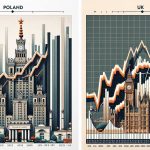
In Poland, Catholicism is the main religion, deeply entwined with the country’s history and identity. But it’s not the only faith you’ll find here. There are also smaller communities, like Jews and Muslims, adding their unique traditions to Poland’s cultural mix.
Plus, there’s a growing interest in the country’s pre-Christian roots, which adds an extra layer to Poland’s spiritual landscape. This mix of old and new, major and minor religions, raises interesting points about how Poland’s religious and cultural identity is changing in today’s world.
The Dominance of Catholicism
In Poland, Catholicism stands as more than just a religious belief; it’s a defining part of what it means to be Polish. A staggering 90% of the country’s population identifies as Catholic, highlighting how deeply this faith intertwines with both the culture and the daily lives of the people. This strong connection has roots in history but remains very much alive today, influencing everything from the way people celebrate holidays to how they engage in political discussions.
The church isn’t just a place for worship in Poland; it’s heavily involved in education and providing social services, making its presence felt in nearly every aspect of daily life. For example, many schools have religion classes that reflect Catholic teachings, and numerous social programs are run by church-affiliated organizations. This widespread involvement underscores the church’s role in shaping not only personal values but also societal norms.
Catholicism’s influence in Poland also reaches into moral and ethical debates, often steering public opinion and even impacting legislation. For instance, discussions on topics like marriage, family life, and bioethics are heavily influenced by Catholic doctrine. The church’s stance on these issues resonates with a large portion of the population, further cementing its role in the public sphere.
This deep integration of Catholicism into the Polish identity shows how religion can shape a nation’s culture, values, and everyday choices. From the way people celebrate Christmas and Easter to the moral principles that guide their decisions, Catholicism’s imprint on Poland is profound and pervasive, making it a key element of what it means to be Polish today.
Minor Religious Communities
In Poland, Catholicism is the major religion, but the country also has a diverse range of smaller religious groups that add to its spiritual landscape. The Eastern Orthodox Church is one of these, with a noticeable following among the Belarusian and Ukrainian communities in Poland. This church is important because it represents a significant portion of the religious minority, underscoring the cultural diversity within the country.
Protestants, although fewer in numbers, play a historical role in Poland’s religious scene. Lutheranism and Calvinism are the main Protestant denominations, primarily found in the northern and western parts of Poland. Their long-standing presence contributes to the religious and cultural tapestry of these regions.
Jehovah’s Witnesses and Pentecostals, though smaller in scale, are active and vibrant communities in Poland. They demonstrate the variety within Poland’s religious landscape, showing that even smaller groups have a place and voice in the broader spiritual conversation.
The Greek Catholic Church is particularly interesting because it serves the Ukrainian minority by blending Orthodox and Catholic traditions. This mix of practices showcases the complex nature of Poland’s religious identity, highlighting how different faiths can merge and coexist in a single community.
The Jewish and Muslim Presence
In Poland, the Jewish and Muslim communities add unique colors to the country’s cultural and religious landscape. Let’s dive into the history and current state of these groups, emphasizing their significance and contributions.
The Jewish community in Poland has a rich history that stretches back centuries. While the Holocaust dramatically reduced their numbers, there’s been a noticeable resurgence in Jewish culture and religion in recent years. This revival is breathing new life into Poland’s multicultural identity. For example, the annual Jewish Culture Festival in Krakow showcases this renaissance, drawing people from all over the world to celebrate Jewish music, art, and history.
On the other hand, the Muslim community in Poland, though smaller, is equally impactful. This group includes the Tatars, who have lived in Poland for hundreds of years, and more recent immigrants. Their presence might be less in numbers but is strong in cultural influence. The Warsaw Mosque and the Muslim Cultural Center are great examples of how this community is making its mark, serving not only as places of worship but also as centers for cultural exchange and understanding.
Both communities, through their religious practices and cultural events, play a crucial role in enriching Poland’s social fabric. They teach us a lot about the power of resilience and the beauty of diversity. By celebrating their traditions and sharing their stories, they help shape a more inclusive and vibrant Poland.
In conversation, talking about these communities can spark interesting discussions about the importance of preserving cultural heritage and promoting tolerance. Whether it’s visiting a Jewish museum to learn about Poland’s Jewish history or attending a cultural event organized by the Muslim community, there are many ways to engage with and appreciate the diverse cultures that make up Poland.
Pre-Christian Traditions Resurgence
In Poland, there’s been a growing interest in pre-Christian traditions, a trend that mirrors a wider desire to explore and embrace historical cultural identities. This movement isn’t just about looking back at the past; it’s about seeking deeper meaning, connection, and a sense of identity. Many Poles are turning to ancient Slavic beliefs and rituals, finding genuine expressions of their ancestral roots in these practices. These traditions often center around nature worship, seasonal cycles, and ancient deities, predating Christianity’s arrival in Poland.
This revival varies in how it’s practiced, but it’s making a noticeable mark on Poland’s religious landscape. It’s introducing a variety of beliefs and practices that illuminate the complex mosaic of faith and identity in the nation. While not yet mainstream, this movement is gaining traction, offering a fresh perspective on Poland’s cultural and spiritual heritage.
For example, celebrations of the summer solstice, known as Kupala Night, have been revived. This ancient festival, which celebrates the longest day of the year, blends fire, water, and fertility rituals with modern festivities. People gather to light bonfires, float wreaths on water, and jump over fires, all practices rooted in Slavic tradition. These celebrations not only connect participants with their history but also with the natural world, reinforcing the importance of seasonal cycles in human life.
This resurgence of pre-Christian traditions in Poland is more than a historical curiosity. It’s a vibrant, living movement that offers Poles a way to connect with their past while exploring their spiritual and cultural identities in the present.
Faith’s Role in Society
In Poland, people are taking a fresh look at old traditions from before Christianity. This interest is not just about culture but also shows how important faith is in shaping Polish society. From what people think is right or wrong to how they come together as a community and even talk about politics, faith is at the heart of it all. Now, with a mix of Christian beliefs and this new interest in older spiritual practices, there’s a rich blend that’s affecting everything from daily life to bigger questions about who the Polish people are.
Let’s break this down with some examples. In terms of ethics, faith might guide someone on how to act fairly in business or to help those in need in their community. When it comes to politics, faith-based views can influence decisions on laws or social policies. This isn’t unique to Poland; many countries see faith playing a role in such areas. However, the reintroduction of pre-Christian traditions into the mix is particularly interesting here. It adds a layer of cultural identity that’s distinct and helps Poles connect with their history in a meaningful way.
This blending of old and new isn’t just about keeping traditions alive for the sake of it. It’s about making sure these beliefs and practices stay relevant and helpful in today’s world. For instance, community gatherings that might have once centered around Christian holidays are now also celebrating pre-Christian festivals. This keeps the community spirit alive and adapts it to modern times.
Understanding this dynamic in Poland shows how adaptable and resilient societies can be. It highlights the importance of faith, not just in a religious sense but as a foundation for how people live together, make decisions, and face challenges. In a world that’s constantly changing, this blend of faith and tradition provides a sense of continuity and identity.
Conclusion
So, Poland is mainly a Catholic country, and this has a big impact on its culture and how people live. But it’s not just about Catholicism.
There are also smaller groups like Jews and Muslims, and some people are getting interested in old traditions from before Christianity. All of this shows that when it comes to religion, Poland is quite a mix.
There’s a lot of history here, but things are also changing with new ideas about faith and spirituality. This blend of the old and the new really shows you what Poland’s religious scene is all about.






Comments are closed.